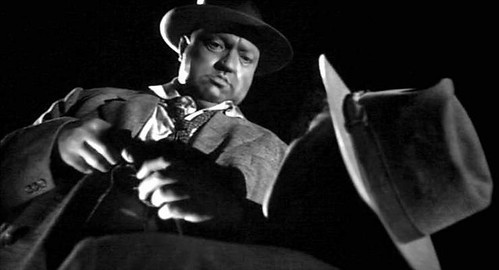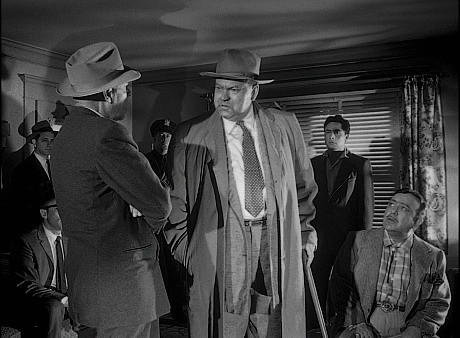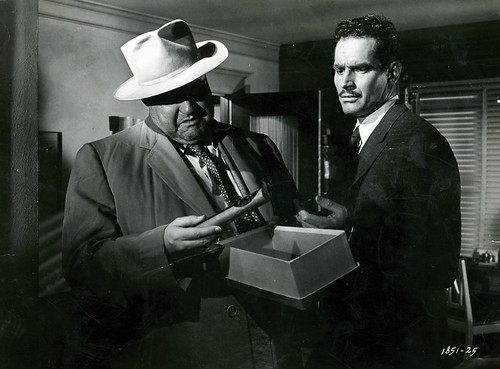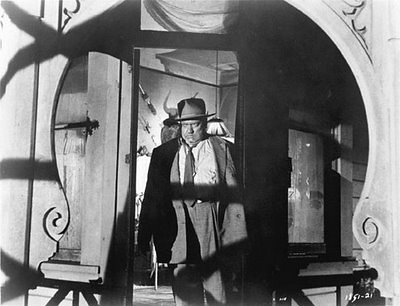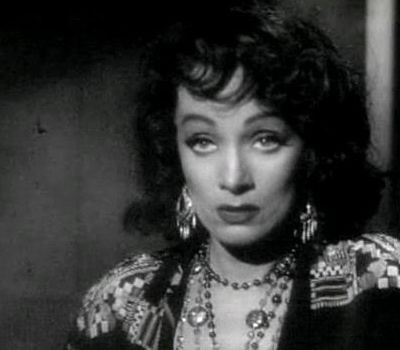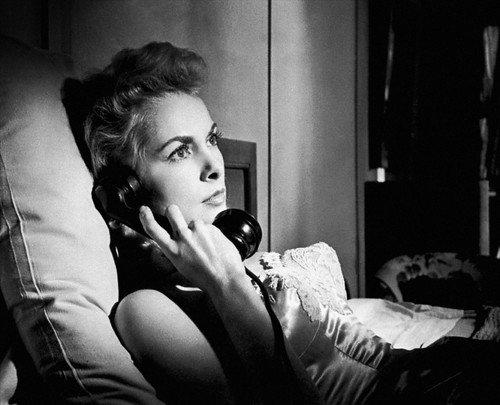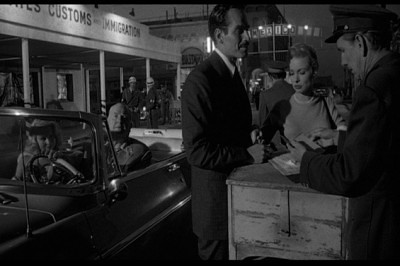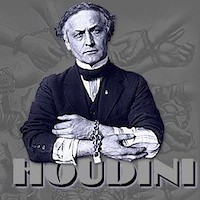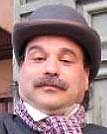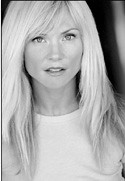TOUCH OF EVIL
Your December Random Movie Club Results Are In!
Tagline: The Overwhelming Drama of a Strange Vengeance
Pizza: We Love Pizza (But they also go by the name of Noho Pizza)
Preshow Entertainment: HOUDINI (American Experience)
Many regard TOUCH OF EVIL (1958) as the last noir movie. That may be so (qualifying that we're talking about noir's golden age), but there's a more invisible thread here, one that ties TOUCH OF EVIL to the birth of New Wave cinema, as it influenced both Truffaut and Godard's first films. Of course, it can be argued that noir itself was born out of Europe's Expressionism, so its influence on the New Wave was, in a way, returning the favor. Still, EVIL's influence is documented by those Wave pioneers, not too shabby for a movie that Orson Welles was never meant to direct. Or write. Or star in. Or get fired from during post production. Yes, as usual, Welles and the studio didn't see eye to eye. In spite of this, he somehow made yet another fantastic movie, or shall I say, "movies," because there's more than one version floating around.
If you think the GOODFELLAS' "Copa shot" was groundbreaking, think again, and then watch the first three and a half minutes of TOUCH OF EVIL. This complicated shot, featuring concurrent events and overlapping source music, fuels the dark, gritty and often humorous (to me, anyway) story; a tale of corruption, drugs, rape and murder. See? Humorous. And one of these funny things is that Charlton Heston plays a Mexican.
So much goes on in the few minutes after That Famous Opening Shot, exposition-wise, that you best keep your eyes and ears open as wide as you can. They're not going to say things twice. Hell, they may not even say things once, as characters talk over each other, you know, like how real conversations go. Nor are they going to spell things out for you like you're a 3rd grader. You need to watch and listen to the first ten minutes of EVIL, or you'll lose your footing.
Vargas (Heston) is a Mexican drug cop newly married to Susie (Janet Leigh), an American. While walking out of their border town of Los Robles and into Texas, a car explodes, but we're not as surprised as the people in the movie. We watched someone put the time bomb in the trunk when the shot began. And even though the crime was committed on the Mexican side, the car exploded on the American side, so there's an American cop on the case - Captain Hank Quinlan (Welles). He's a portly (don't let him fool you, he's in a fat suit with fake jowls and eye bags), obdurate cop who mumbles to himself while waddling, like the bastard child of Mr. Magoo and The Penguin. Quinlan, who uses a cane to assist his game leg and body of girth, makes a great movie entrance - spilling out of the car. And that cane isn't just a sly callback to a former citizen, it will also be part of a major plot point. Many of the bad guys in EVIL are shot from the ground up so they are looking down their noses at us. Perhaps it's foreshadowing that Quinlan is shot this way when we first see him.
We learn that Vargas is prosecuting the leader of the Grandis, a local crime family now headed by Uncle Joe (Akim Tamiroff). They don't like Vargas, and they certainly don't like Quinlan and his police-pal Menzies (Joseph Calleia) ("Who made me an honest cop? Hank Quinlan.") putting their noses where they don't (but really do) belong. Added to this, the mystery of who planted that bomb in the car that killed Linnekar, a prominent businessman. I save that for last because it's actually the least important part of this movie. It could have been any crime. It's what the crime triggered, the events that followed that makes EVIL so evil.
While Quinlan and Vargas have a pissing contest (VARGAS: "You won't have any trouble with me." QUINLAN: "You can bet your sweet life I won't."), Susie gets kidnapped (sort of) by Uncle Joe, who can't seem to keep his hairpiece on. These two stories run on parallel tracks, but manage to meet up once or twice. At one point in Los Robles, Quinlan spots an old haunt, a brothel run by Tanya (Marlene Dietrich), the epitome of hard and a good match for Quinlan. But she doesn't even recognize him ("You're a mess.") from their relationship years ago. Eventually, righteous Vargas begins to suspect that Quinlan isn't as legendary as his reputation suggests, especially when Quinlan tries, at any cost, to nail Sanchez (Victor Millan) for the car bomb. And on top of that, Menzies, who idolizes Quinlan, is starting to smell that smell too. Something's gotta give.
It's said that Welles enjoyed doing this movie more than any of his others, and I believe it shows. He is a presence here; traipsing around like the owner of some West Indies island during the spice trade, he's both menacing and comical. It's QuinlanWorld, populated by insects that are simply bothersome.
Again, people go gaga over EVIL's opening shot. And they should. But you don't have to dig deep to find tons of other moments. There's another shot, even longer (almost four and a half minutes), that occurs in an apartment with suspect Sanchez and many of the main players. In a way, it's more impressive than the opening shot as it's a lot of people in a confined area, some moving around from living room to (unseen) bedroom to bathroom. And it's capped by a moment that I believe to be the smarter one - as Vargas crosses the street to use a phone, he (and us too, if we're not paying attention) doesn't notice a car pulling up with Menzies and Uncle Joe. When Vargas enters the store, the car is in the reflection of the store window, and as Vargas talks on the phone in the store, we see Menzies and Uncle Joe's dueling shenanigans playing out through the window. Also, when incriminating evidence is found in Sanchez's apartment, we hear the whole thing go down, but Welles smartly chooses to keep the camera close on Vargas, a man who already has suspicions about both Sanchez's guilt and Quinlan's integrity. Similarly, there's a wonderful shot that holds on Menzies as he watches Quinlan, who once stopped a bullet for him (that's why he has the game leg), leave with criminal Grandi. Menzies' face says it all - his mentor may not be the man he thought he was.
Then there are the smaller moments, though no less significant (or cool), like when Quinlan and Vargas go head to head (VARGAS: "You framed him!") and Vargas just won't stand down, no matter how close the fat, greasy Quinlan and his cane get in his face. It's a thing of beauty. Or how Quinlan washes the blood off his hands, literally, in sludge and muck.
As a director, Welles was, once again, a master. He employed one of the first uses of hand held cameras in American film (he saw them in France). This made it possible to film a scene with dialogue in an actual moving car instead of using rear projection. And speaking of sound, the use of source music and sounds is astonishing, if you listen for it. Welles incorporates everything from car radios to radio receivers and even a player piano, always adjusting the volumes to where "we" are at the moment. And like the dialogue and the choreography, the sounds overlap as well.
Shot in black and white (Welles didn't have much love for color) and taking place almost entirely at night, Welles creates a story of corruption set against a backdrop of a border town (VARGAS: " All border towns bring out the worst in a country") dotted with pumping oil wells and wind-swept trash. Doubling for Los Robles (a billboard calls it "the Paris of the border") is Venice, California, then a town in need of a facelift. If you walk through Venice today, you'll still see streets and buildings used in EVIL.
Welles would often rewrite the script during lunches, making it harder on the actors, who sometimes would be called in on unscheduled days...at 3am. That's how much people wanted to work with him. Frequently, actors didn't even know who would pop up on set, even in the smallest of roles, like Joseph Cotton and Zsa Zsa Gabor. Dietrich's small but important role was filmed in one night, the last one of the shoot, I think. Of course, the studio was clueless. When they watched the rushes - "Is that Marlene Dietrich??" Speaking of actors, Dennis Weaver is over the top (remember before I said EVIL was funny?) as the creepy, mousy night manager of a rundown motel...and with Janet Leigh as its only guest, I wouldn't be the first to call PSYCHO (which came a few years later) similarities. Here, Weaver, like Norman Bates, is a stammering, slow, shy (yet rebellious when triggered) oddball. A man so scared (how can you be a night clerk at a hotel and be this frightened all the time?) he can't even say the word "bed" to Susie without twitching.
TOUCH OF EVIL, from a novel by Whit Masterson called BADGE OF HONOR (recently listed on eBay for $3500.00. No, it didn't sell.), is a great movie, a classic, for sure. The cut Welles delivered doesn't exist anymore because Universal not only re-edited it, but also shot new footage with another director, Harry Keller. When they screened this cut for Welles, he went home and crafted a 58-page memo regarding changes. Guess what? They were largely ignored. The movie released in theaters was shorter and confusing, and thus, relegated to B-movie status.
Twenty years later, a longer print was discovered and released as "Uncut and restored," which is a touch of an evil lie. They simply added more footage from both Welles and Keller, though why this added Keller footage, originally meant to save the film in the first place, was not in the original theatrical cut remains a mystery. Another twenty or so years go by when Welles' 58-page note is discovered and published. With some pushing and shoving, EVIL freak Rick Schmidlin convinced Universal to re-cut the film using these notes, making this 1998 version the closest thing to a director's cut we'll ever get. They also restored the movie and re-released it theatrically. Though the 50th Anniversary DVD has all three versions, it's the 1998 restored version that holds the most gold. Among the many changes, it removes the soundtrack music (a percussive-happy Henry Mancini) and titles from The Opening Shot, which Welles rightfully saw as a distraction. By the way, that shot took all night, and they didn't get it right until the very last take (you can even see it getting light out). The reason? The border guard at the tail end of the shot kept screwing up his line.
There are some really great extras on the 50th anniversary DVD, like EVIL LOST AND FOUND which examines the restoration with its editor and producer (Walter Murch and Rick Schmidlin). There's also interviews with film geeks George Lucas, the late Robert Wise, Peter Bogdanovich (who knew Welles) and Curtis Hanson, who is sitting in front of records and behind a manual typewriter. Act now and you get not one, two or three, but four commentaries, one of which features Schmidlin and both Charlton Heston and Janet Leigh. This is huge, not just because the actors are no longer with us, but because at that time very few people had heard of DVDs (they hit the market gradually, between the summer of '97 and the summer of '98), let alone owned a DVD player. Even though the word 'DVD' is mentioned on the commentary, I believe these tracks were all produced for laserdiscs.
Again, it's clear Welles was ahead of his time. Why, even his padded Quinlan suit foreshadowed the man's forthcoming frame of fat. Christ, even he knew he was ahead of his time: "They're going to love me when I'm dead."
I believe Houdini's biggest magic trick is that everyone reading this will answer "Houdini" when asked who the world's greatest magician is, even though none of us have seen him perform live. So, how do we know that? Because Erich Weiss (he took the name Houdini from Jean Robert-Houdin, a French magician) lied about everything, including where he was born. Harry Houdini was, more than anything, a publicity whore, and I mean that in the kindest, most respectful way. Because I love Harry Houdini. And I'm not alone. Right now, there are no fewer than three Houdini films in active development.
This documentary, new to DVD (but aired at the turn of this century), won't tell you much that you don't know if you're a Houdini nut. But if you're not, it's the one to watch (there are a few Houdini docs out there). With interviews from people like James (The Amazing) Randi, David Copperfield and Houdini biographer Ken Silverman, it really shines a light into the life of Harry. One thing I didn't know, he was the first person to fly a plane in Australia...part of his desire to have a legacy (which apparently didn't work in this case).
There's some great stills and footage in this doc. So here's your chance to see the real version (not the Tony Curtis one, though I do love that movie) of how Houdini rose from poverty to be the world's greatest magician. He is the world's greatest magician, right?
Tagline: The Overwhelming Drama of a Strange Vengeance
Pizza: We Love Pizza (But they also go by the name of Noho Pizza)
Preshow Entertainment: HOUDINI (American Experience)
WHOEVER FIGHTS MONSTERS
SHOULD SEE TO IT THAT IN THE PROCESS
HE DOES NOT BECOME A MONSTER.
-NIETZSCHE
SHOULD SEE TO IT THAT IN THE PROCESS
HE DOES NOT BECOME A MONSTER.
-NIETZSCHE
Many regard TOUCH OF EVIL (1958) as the last noir movie. That may be so (qualifying that we're talking about noir's golden age), but there's a more invisible thread here, one that ties TOUCH OF EVIL to the birth of New Wave cinema, as it influenced both Truffaut and Godard's first films. Of course, it can be argued that noir itself was born out of Europe's Expressionism, so its influence on the New Wave was, in a way, returning the favor. Still, EVIL's influence is documented by those Wave pioneers, not too shabby for a movie that Orson Welles was never meant to direct. Or write. Or star in. Or get fired from during post production. Yes, as usual, Welles and the studio didn't see eye to eye. In spite of this, he somehow made yet another fantastic movie, or shall I say, "movies," because there's more than one version floating around.
If you think the GOODFELLAS' "Copa shot" was groundbreaking, think again, and then watch the first three and a half minutes of TOUCH OF EVIL. This complicated shot, featuring concurrent events and overlapping source music, fuels the dark, gritty and often humorous (to me, anyway) story; a tale of corruption, drugs, rape and murder. See? Humorous. And one of these funny things is that Charlton Heston plays a Mexican.
So much goes on in the few minutes after That Famous Opening Shot, exposition-wise, that you best keep your eyes and ears open as wide as you can. They're not going to say things twice. Hell, they may not even say things once, as characters talk over each other, you know, like how real conversations go. Nor are they going to spell things out for you like you're a 3rd grader. You need to watch and listen to the first ten minutes of EVIL, or you'll lose your footing.
Vargas (Heston) is a Mexican drug cop newly married to Susie (Janet Leigh), an American. While walking out of their border town of Los Robles and into Texas, a car explodes, but we're not as surprised as the people in the movie. We watched someone put the time bomb in the trunk when the shot began. And even though the crime was committed on the Mexican side, the car exploded on the American side, so there's an American cop on the case - Captain Hank Quinlan (Welles). He's a portly (don't let him fool you, he's in a fat suit with fake jowls and eye bags), obdurate cop who mumbles to himself while waddling, like the bastard child of Mr. Magoo and The Penguin. Quinlan, who uses a cane to assist his game leg and body of girth, makes a great movie entrance - spilling out of the car. And that cane isn't just a sly callback to a former citizen, it will also be part of a major plot point. Many of the bad guys in EVIL are shot from the ground up so they are looking down their noses at us. Perhaps it's foreshadowing that Quinlan is shot this way when we first see him.
We learn that Vargas is prosecuting the leader of the Grandis, a local crime family now headed by Uncle Joe (Akim Tamiroff). They don't like Vargas, and they certainly don't like Quinlan and his police-pal Menzies (Joseph Calleia) ("Who made me an honest cop? Hank Quinlan.") putting their noses where they don't (but really do) belong. Added to this, the mystery of who planted that bomb in the car that killed Linnekar, a prominent businessman. I save that for last because it's actually the least important part of this movie. It could have been any crime. It's what the crime triggered, the events that followed that makes EVIL so evil.
While Quinlan and Vargas have a pissing contest (VARGAS: "You won't have any trouble with me." QUINLAN: "You can bet your sweet life I won't."), Susie gets kidnapped (sort of) by Uncle Joe, who can't seem to keep his hairpiece on. These two stories run on parallel tracks, but manage to meet up once or twice. At one point in Los Robles, Quinlan spots an old haunt, a brothel run by Tanya (Marlene Dietrich), the epitome of hard and a good match for Quinlan. But she doesn't even recognize him ("You're a mess.") from their relationship years ago. Eventually, righteous Vargas begins to suspect that Quinlan isn't as legendary as his reputation suggests, especially when Quinlan tries, at any cost, to nail Sanchez (Victor Millan) for the car bomb. And on top of that, Menzies, who idolizes Quinlan, is starting to smell that smell too. Something's gotta give.
It's said that Welles enjoyed doing this movie more than any of his others, and I believe it shows. He is a presence here; traipsing around like the owner of some West Indies island during the spice trade, he's both menacing and comical. It's QuinlanWorld, populated by insects that are simply bothersome.
Again, people go gaga over EVIL's opening shot. And they should. But you don't have to dig deep to find tons of other moments. There's another shot, even longer (almost four and a half minutes), that occurs in an apartment with suspect Sanchez and many of the main players. In a way, it's more impressive than the opening shot as it's a lot of people in a confined area, some moving around from living room to (unseen) bedroom to bathroom. And it's capped by a moment that I believe to be the smarter one - as Vargas crosses the street to use a phone, he (and us too, if we're not paying attention) doesn't notice a car pulling up with Menzies and Uncle Joe. When Vargas enters the store, the car is in the reflection of the store window, and as Vargas talks on the phone in the store, we see Menzies and Uncle Joe's dueling shenanigans playing out through the window. Also, when incriminating evidence is found in Sanchez's apartment, we hear the whole thing go down, but Welles smartly chooses to keep the camera close on Vargas, a man who already has suspicions about both Sanchez's guilt and Quinlan's integrity. Similarly, there's a wonderful shot that holds on Menzies as he watches Quinlan, who once stopped a bullet for him (that's why he has the game leg), leave with criminal Grandi. Menzies' face says it all - his mentor may not be the man he thought he was.
Then there are the smaller moments, though no less significant (or cool), like when Quinlan and Vargas go head to head (VARGAS: "You framed him!") and Vargas just won't stand down, no matter how close the fat, greasy Quinlan and his cane get in his face. It's a thing of beauty. Or how Quinlan washes the blood off his hands, literally, in sludge and muck.
As a director, Welles was, once again, a master. He employed one of the first uses of hand held cameras in American film (he saw them in France). This made it possible to film a scene with dialogue in an actual moving car instead of using rear projection. And speaking of sound, the use of source music and sounds is astonishing, if you listen for it. Welles incorporates everything from car radios to radio receivers and even a player piano, always adjusting the volumes to where "we" are at the moment. And like the dialogue and the choreography, the sounds overlap as well.
Shot in black and white (Welles didn't have much love for color) and taking place almost entirely at night, Welles creates a story of corruption set against a backdrop of a border town (VARGAS: " All border towns bring out the worst in a country") dotted with pumping oil wells and wind-swept trash. Doubling for Los Robles (a billboard calls it "the Paris of the border") is Venice, California, then a town in need of a facelift. If you walk through Venice today, you'll still see streets and buildings used in EVIL.
Welles would often rewrite the script during lunches, making it harder on the actors, who sometimes would be called in on unscheduled days...at 3am. That's how much people wanted to work with him. Frequently, actors didn't even know who would pop up on set, even in the smallest of roles, like Joseph Cotton and Zsa Zsa Gabor. Dietrich's small but important role was filmed in one night, the last one of the shoot, I think. Of course, the studio was clueless. When they watched the rushes - "Is that Marlene Dietrich??" Speaking of actors, Dennis Weaver is over the top (remember before I said EVIL was funny?) as the creepy, mousy night manager of a rundown motel...and with Janet Leigh as its only guest, I wouldn't be the first to call PSYCHO (which came a few years later) similarities. Here, Weaver, like Norman Bates, is a stammering, slow, shy (yet rebellious when triggered) oddball. A man so scared (how can you be a night clerk at a hotel and be this frightened all the time?) he can't even say the word "bed" to Susie without twitching.
TOUCH OF EVIL, from a novel by Whit Masterson called BADGE OF HONOR (recently listed on eBay for $3500.00. No, it didn't sell.), is a great movie, a classic, for sure. The cut Welles delivered doesn't exist anymore because Universal not only re-edited it, but also shot new footage with another director, Harry Keller. When they screened this cut for Welles, he went home and crafted a 58-page memo regarding changes. Guess what? They were largely ignored. The movie released in theaters was shorter and confusing, and thus, relegated to B-movie status.
Twenty years later, a longer print was discovered and released as "Uncut and restored," which is a touch of an evil lie. They simply added more footage from both Welles and Keller, though why this added Keller footage, originally meant to save the film in the first place, was not in the original theatrical cut remains a mystery. Another twenty or so years go by when Welles' 58-page note is discovered and published. With some pushing and shoving, EVIL freak Rick Schmidlin convinced Universal to re-cut the film using these notes, making this 1998 version the closest thing to a director's cut we'll ever get. They also restored the movie and re-released it theatrically. Though the 50th Anniversary DVD has all three versions, it's the 1998 restored version that holds the most gold. Among the many changes, it removes the soundtrack music (a percussive-happy Henry Mancini) and titles from The Opening Shot, which Welles rightfully saw as a distraction. By the way, that shot took all night, and they didn't get it right until the very last take (you can even see it getting light out). The reason? The border guard at the tail end of the shot kept screwing up his line.
There are some really great extras on the 50th anniversary DVD, like EVIL LOST AND FOUND which examines the restoration with its editor and producer (Walter Murch and Rick Schmidlin). There's also interviews with film geeks George Lucas, the late Robert Wise, Peter Bogdanovich (who knew Welles) and Curtis Hanson, who is sitting in front of records and behind a manual typewriter. Act now and you get not one, two or three, but four commentaries, one of which features Schmidlin and both Charlton Heston and Janet Leigh. This is huge, not just because the actors are no longer with us, but because at that time very few people had heard of DVDs (they hit the market gradually, between the summer of '97 and the summer of '98), let alone owned a DVD player. Even though the word 'DVD' is mentioned on the commentary, I believe these tracks were all produced for laserdiscs.
Again, it's clear Welles was ahead of his time. Why, even his padded Quinlan suit foreshadowed the man's forthcoming frame of fat. Christ, even he knew he was ahead of his time: "They're going to love me when I'm dead."
PRESHOW ENTERTAINMENT: HOUDINI (American Experience)
I believe Houdini's biggest magic trick is that everyone reading this will answer "Houdini" when asked who the world's greatest magician is, even though none of us have seen him perform live. So, how do we know that? Because Erich Weiss (he took the name Houdini from Jean Robert-Houdin, a French magician) lied about everything, including where he was born. Harry Houdini was, more than anything, a publicity whore, and I mean that in the kindest, most respectful way. Because I love Harry Houdini. And I'm not alone. Right now, there are no fewer than three Houdini films in active development.
This documentary, new to DVD (but aired at the turn of this century), won't tell you much that you don't know if you're a Houdini nut. But if you're not, it's the one to watch (there are a few Houdini docs out there). With interviews from people like James (The Amazing) Randi, David Copperfield and Houdini biographer Ken Silverman, it really shines a light into the life of Harry. One thing I didn't know, he was the first person to fly a plane in Australia...part of his desire to have a legacy (which apparently didn't work in this case).
There's some great stills and footage in this doc. So here's your chance to see the real version (not the Tony Curtis one, though I do love that movie) of how Houdini rose from poverty to be the world's greatest magician. He is the world's greatest magician, right?

